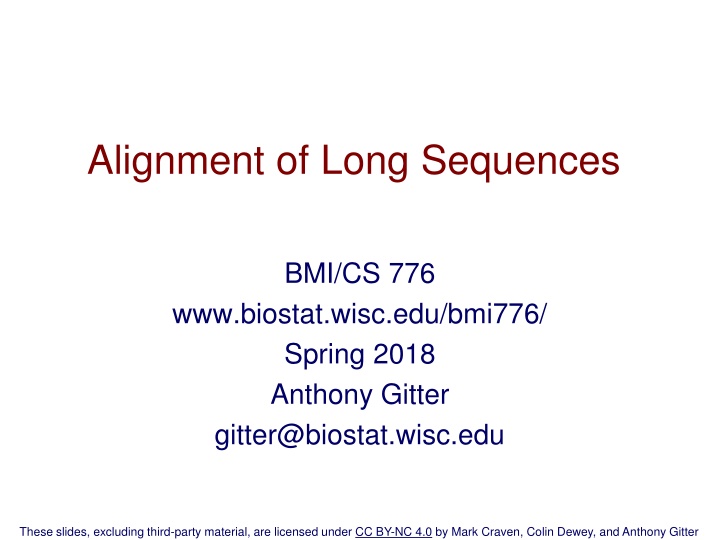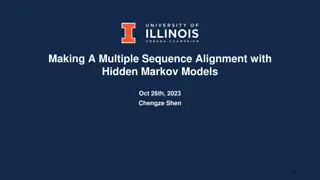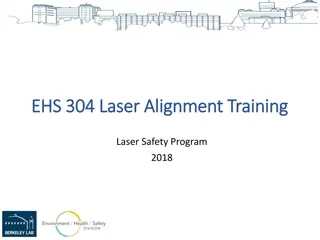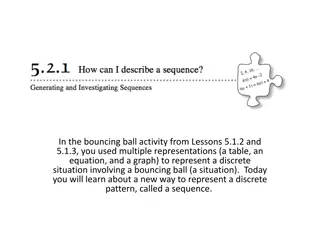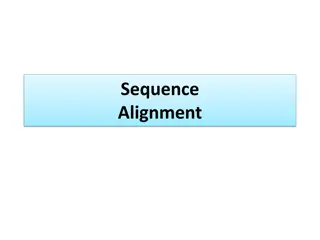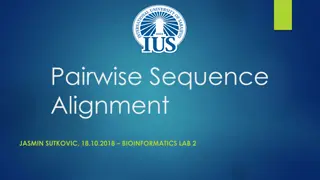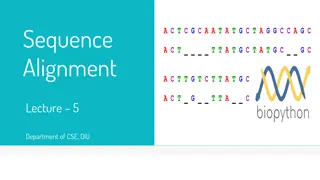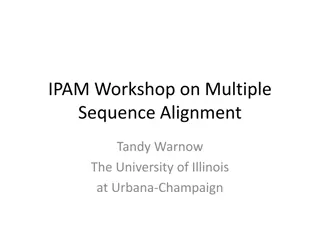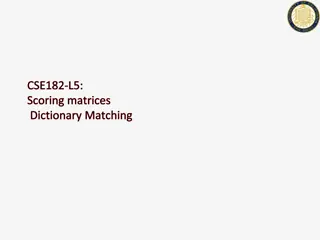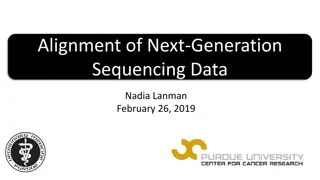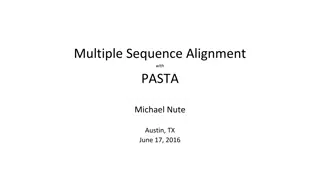Large-Scale Sequence Alignment Techniques Overview
Lecture slides discuss key concepts, goals, challenges, and strategies for aligning long sequences, focusing on methods like suffix trees, dynamic programming, and pattern matching. The MUMmer system for finding maximal unique matching subsequences is explored along with examples of large-scale alignments between mouse and human chromosomes.
Download Presentation

Please find below an Image/Link to download the presentation.
The content on the website is provided AS IS for your information and personal use only. It may not be sold, licensed, or shared on other websites without obtaining consent from the author.If you encounter any issues during the download, it is possible that the publisher has removed the file from their server.
You are allowed to download the files provided on this website for personal or commercial use, subject to the condition that they are used lawfully. All files are the property of their respective owners.
The content on the website is provided AS IS for your information and personal use only. It may not be sold, licensed, or shared on other websites without obtaining consent from the author.
E N D
Presentation Transcript
Alignment of Long Sequences BMI/CS 776 www.biostat.wisc.edu/bmi776/ Spring 2018 Anthony Gitter gitter@biostat.wisc.edu These slides, excluding third-party material, are licensed under CC BY-NC 4.0 by Mark Craven, Colin Dewey, and Anthony Gitter
Goals for Lecture Key concepts how large-scale alignment differs from the simple case the canonical three step approach of large-scale aligners using suffix trees to find maximal unique matching subsequences (MUMs) If time permits using tries and threaded tries to find alignment seeds constrained dynamic programming to align between/around anchors using sparse dynamic programming (DP) to find a chain of local alignments 2
Pairwise Large-Scale Alignment: Task Definition Given a pair of large-scale sequences (e.g. chromosomes) a method for scoring the alignment (e.g. substitution matrices, insertion/deletion parameters) Do construct global alignment: identify all matching positions between the two sequences 3
Large Scale Alignment Example Mouse Chr6 vs. Human Chr12 Figure from: Delcher et al., Nucleic Acids Research 27, 1999 4
Why the Problem is Challenging Sequences too big to make O(n2) dynamic- programming methods practical Long sequences are less likely to be colinear because of rearrangements initially we ll assume colinearity we ll consider rearrangements in next lecture (or never) 5
General Strategy Figure from: Brudno et al. Genome Research, 2003 1. perform pattern matching to find seeds for global alignment 2. find a good chain of anchors 3. fill in remainder with standard but constrained alignment method 6
The MUMmer System Delcher et al., Nucleic Acids Research, 1999 Given: genomes A and B 1. find all maximal unique matching subsequences (MUMs) 2. extract the longest possible set of matches that occur in the same order in both genomes 3. close the gaps 7
Step 1: Finding Seeds in MUMmer Maximal unique match: occurs exactly once in both genomes A and B not contained in any longer MUM mismatches Key insight: a significantly long MUM is certain to be part of the global alignment 8
Suffix Trees Substring problem: given text S of length m preprocess Sin O(m) time such that, given query string Q of length n, find occurrence (if any) of Qin S in O(n) time Suffix trees solve this problem and others 9
Suffix Tree Definition A suffix tree T for a string Sof length m is a tree with the following properties: rooted and directed m leaves, labeled 1 to m each edge labeled by a substring of S concatenation of edge labels on path from root to leaf iis suffix i of S(we will denote this by Si...m) each internal non-root node has at least two children edges out of a node must begin with different characters key property 10
Suffixes S= banana$ suffixes of S $ a$ na$ ana$ nana$ anana$ banana$ (special character) 11
Suffix Tree Example S= banana$ Add $ to end so that suffix tree exists (no suffix is a prefix of another suffix) a b a na n a $ na n a $ $ n n a $ a $ $ 7 $ 2 4 6 1 3 5 12
Solving the Substring Problem Assumewe have suffix tree T and query string Q FindMatch(Q, T): follow (unique) path down from root of Taccording to characters in Q if all of Qis found to be a prefix of such a path return label of some leaf below this path else, return no match found 13
Solving the Substring Problem Q = nan Q = anab a a b a na n a $ b a na n a $ na na n n a a $ $ STOP $ $ n n n a $ n a $ a a $ $ $ 7 $ $ 7 $ 4 2 2 4 6 1 5 6 3 1 5 3 return 3 return no match found 14
MUMs and Generalized Suffix Trees Build one suffix tree for both genomes A and B Label each leaf node with genome it represents each internal node represents a repeated sequence Genome A: ccacg# Genome B: cct$ t$ acg# c g# B, 3 A, 3 A, 5 acg# t$ c g# A, 2 A, 4 B, 2 acg# t$ A, 1 B, 1 each leaf represents a suffix and its position in sequence 15
MUMs and Suffix Trees Unique match: internal node with 2 children, leaf nodes from different genomes But these matches are not necessarily maximal Genome A: ccacg# Genome B: cct$ t$ acg# c g# B, 3 A, 3 A, 5 acg# t$ c g# A, 2 A, 4 B, 2 acg# t$ represents unique match A, 1 B, 1 16
MUMs and Suffix Trees To identify maximal matches, can compare suffixes following unique match nodes Genome A: acat# Genome B: acaa$ t# a ca A, 4 a$ $ a$ ca t# t# A, 2 B, 2 B, 4 B, 3 A, 3 the suffixes following these two match nodes are the same; the left one represents a longer match (aca) t# a$ A, 1 B, 1 17
Using Suffix Trees to Find MUMs O(n) time to construct suffix tree for both sequences (of lengths n) O(n) time to find MUMs - one scan of the tree (which is O(n) in size) O(n) possible MUMs in contrast to O(n2) possible exact matches Main parameter of approach: length of shortest MUM that should be identified (20 50 bases) 18
Step 2: Chaining in MUMmer Sort MUMs according to position in genome A Solve variation of Longest Increasing Subsequence (LIS) problem to find sequences in ascending order in both genomes Figure from: Delcher et al., Nucleic Acids Research 27, 1999 19
Finding Longest Subsequence Unlike ordinary LIS problems, MUMmer takes into account lengths of sequences represented by MUMs overlaps Requires time where k is number of MUMs ) log ( k k O 20
Recall: Three Main Steps of Large- Scale Alignment Brudno et al. Genome Research, 2003 General 1. Pattern matching to find seeds for global alignment 2. Find a good chain of anchors 3. Fill in with standard but constrained alignment MUMmer 1. Suffix trees to obtain MUMs 2. LIS to find colinear MUMs 3. Smith-Waterman and recursive MUMmer for gap filling 21
Types of Gaps in a MUMmer Alignment Figure from: Delcher et al., Nucleic Acids Research 27, 1999 22
Step 3: Close the Gaps SNPs: between MUMs: trivial to detect otherwise: handle like repeats Insertions simple insertions: trivial to detect transpositions (subsequences that were deleted from one location and inserted elsewhere): look for out-of-sequence MUMs 23
Step 3: Close the Gaps Polymorphic regions short ones: align them with dynamic programming method long ones: call MUMmer recursively with reduced minimum MUM length Repeats detected by overlapping MUMs Figure from: Delcher et al. Nucleic Acids Research 27, 1999 24
MUMmer Performance FASTA on 1000 base pair segments MUMmer Figure from: Delcher et al. Nucleic Acids Research 27, 1999 25
MUMmer Performance DEC Alpha 4100 Mycoplasma test case Suffix tree: 6.5s LIS: 0.02s Smith-Waterman: 116s FASTA baseline: many hours Centre for Computing History 26
Longevity of MUMmer Antimicrobial Resistance Identification By Assembly (ARIBA) Identify antimicrobial resistance genes from Illumina reads Figure from: Hunt et al. bioRxiv 2017 27
Longevity of MUMmer Whole genome alignment still an active area of research Jain et al. 2018 (Mashmap2): we were able to map an error-corrected whole-genome NA12878 human assembly to the hg38 human reference genome in about one minute total execution time and < 4 GB memory using 8 CPU threads Uses MUMmer as ground truth in evaluation 28
Limitations of MUMmer MUMs are perfect matches, typically 20-50 base pairs Evolutionarily distant may not have sufficient MUMs to anchor global alignment How can we tolerate minor variation in the seeds? 29
LAGAN: Three Main Steps Brudno et al. Genome Research, 2003 General 1. Pattern matching to find seeds for global alignment 2. Find a good chain of anchors 3. Fill in with standard but constrained alignment LAGAN 1. Threaded tries to obtain seeds 2. Sparse dynamic programming for chaining 3. Dynamic programming for gap filling 30
Step 1: Finding Seeds in LAGAN Degenerate k-mers: matching k-long sequences with a small number of mismatches allowed By default, LAGAN uses 10-mers and allows 1 mismatch cacg cgcgctacat acct acta cgcggtacat cgta 31
Finding Seeds in LAGAN Example: a trie to represent all 3-mers of the sequence gaaccgacct a c g a c c g a c a c t a c g 2 3, 7 4 8 5 1 6 One sequence is used to build the trie The other sequence (the query) is walked through to find matching k-mers 32
Allowing Degenerate Matches Suppose we re allowing 1 base to mismatch in looking for matches to the 3-mer acc; need to explore green nodes a c g a c c g a c a c t a c g 2 3, 7 4 8 5 1 6 33
LAGAN Uses Threaded Tries In a threaded trie, each leaf for word w1...wk has a back pointer to the node for w2...wk a c g a c c g a c a c t a c g 2 3, 7 4 8 5 1 6 34
Traversing a Threaded Trie Consider traversing the trie to find 3-mer matches for the query sequence: accgt a c g a c c g a c a c t a c g 2 3, 7 4 8 5 1 6 Usually requires following only two pointers to match against the next k-mer, instead of traversing tree from root for each 35
Comparing MUMmer and LAGAN Chimpanzee 176 Zebrafish 48 Chicken 68 Baboon 232 Overall Mouse 230 Fugu 150 Cow 224 Dog 182 Rat 230 Cat 176 Pig 174 Exons 1914 MUMmer (% human exons covered by 90% alignment) LAGAN (% human exons covered by 90% alignment) 100 100 8 9 40 44 47 37 0 0 0 41 100 100 100 100 99 100 100 99 99 88 77 98 36
Comparing MUMmer and LAGAN Brudno et al. Genome Research, 2003 1. Pattern matching to find seeds for global alignment 2. Find a good chain of anchors 3. Fill in with standard but constrained alignment MUMmer 1. Suffix trees to obtain MUMs 2. Longest Increasing Subsequence 3. Smith-Waterman, recursive MUMmer LAGAN 1. k-mer trie to obtain seeds 2. Spare dynamic programming 3. Dynamic programming 37
Multiple Whole Genome Alignment: Task Definition Given A set of n > 2 genomes (or other large-scale sequences) Do Identify all corresponding positions between all genomes, allowing for substitutions, insertions/deletions, and rearrangements 38
Progressive Alignment Given a guide tree relating n genomes Construct multiple alignment by performing n-1 pairwise alignments 39
Progressive Alignment: MLAGAN Example human chimpanzee mouse rat align pairs of sequences align multi-sequences (alignments) chicken align multi-sequence with sequence 40
Progressive Alignment: MLAGAN Example Suppose we re aligning the multi-sequence X/Y with Z 1. anchors from X-Z and Y-Z become anchors for X/Y-Z overlapping anchors are reweighted LIS algorithm is used to chain anchors 2. 3. Figure from: Brudno et al. Genome Research, 2003 41
Genome Rearrangements ancestor ancestor x y a b c d e a b c d e extant species a d c b e extant species d e inversion a b c x y translocation Can occur within a chromosome or across chromosomes Can have combinations of these events 42
Mercator: Rough Orthology Map k-partite graph with edge weights vertices = anchors, edges = sequence similarity 43
Refining the Map: Finding Breakpoints Breakpoints: the positions at which genomic rearrangements disrupt colinearity of segments Mercator finds breakpoints by using inference in an undirected graphical model 44
The Breakpoint Graph 1 2 3 4 5 8 6 7 9 10 11 12 11 9 3 1 5 6 10 8 4 2 7 12 some prefix of region 2 and some prefix of region 11 should be aligned 45
Comparing MLAGAN and Mercator MLAGAN Requires phylogenetic tree Greedy solution with local refinement Mercator Define probabilistic model to solve globally Inference is intractable, resort to approximations 46
